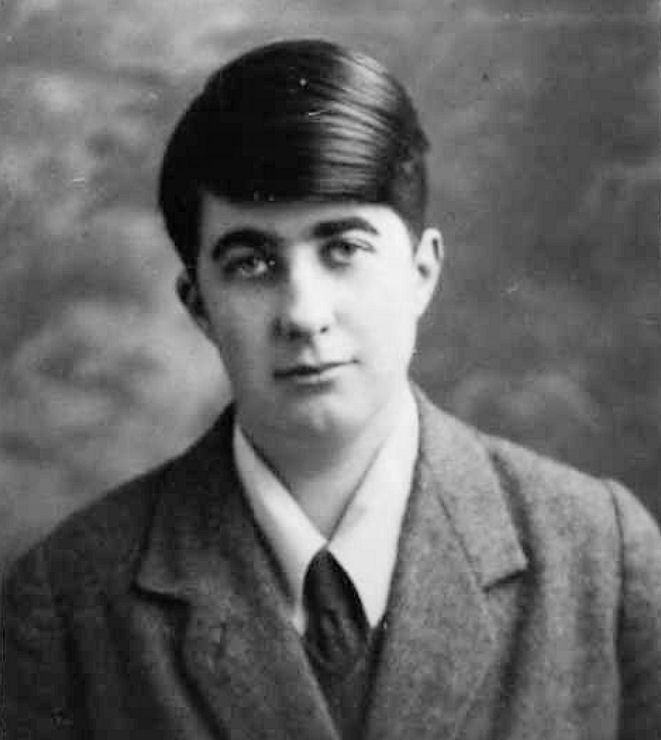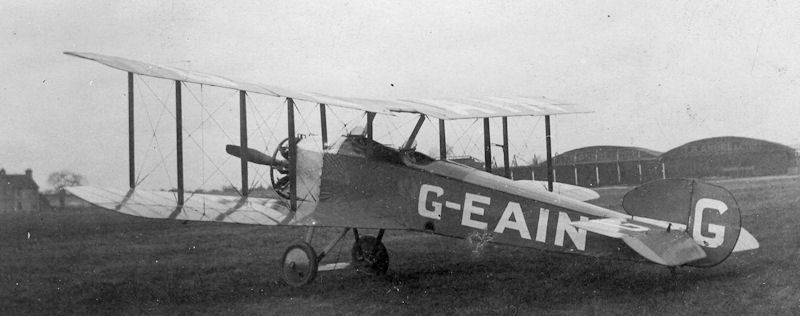Father: Thomas Headley Leathart, a Lead Manufacturer, mother: Janet Ruth Grant "Five foot three and of generous proportions" (Lettice Curtis);
[Check] "a very experienced pre-war racing pilot and ... looked like George Robey" (Mary du Bunsen). [I'm not so sure this is fair ... here's a picture of George Robey for comparison:
Hmmm...] "One of the first 20 British women pilots to obtain the RAeC certificate, and the first outside London" [Amazing - as Connie got her certificate No. 8,085 in 1927, 14 years after the first woman pilot Hilda Hewlett - but true; she was only the 12th woman to get an RAeC certificate. And the previous 11 women had obtained their certificates at one of Hendon, Brooklands, Northolt or Edgeware, all more-or-less London]
l to r Edith Chalmers, Adelaide Cleaver, Sir Sefton Brancker, Rosalind Norman and Connie before the start of the 1930 Heston Spring Flying Cruise to Germany In the late 1920s and early 1930s, with Leslie Runciman (q.v.), she ran Cramlington Aircraft, a company which repaired damaged aeroplanes. She also designed and flew her own glider.
Leslie Runciman and Connie (centre) She was educated at Cheltenham Ladies College, and then Ethelburgas School back in Newcastle. By 1939, her mother had moved to Ottery St Mary in Devon, but Connie was still in the north-east, at Morpeth in Northumberland. In December 1939, aged 35, working in the map department at Bristol Airport, she applied to join the Air Transport Auxiliary (ATA). Her experience at the time was over 700 hours, making her one of the most experienced women pilots in the UK, so she started as soon as they could sort themselves out (Pauline Gower was only allowed to take on 8 women to begin with) ... which turned out to be August 1940. Connie owned
Address in 1940: Mill Greens, Angerton, Morpeth, Northumberland
Mary du Bunsen says that "Connie hated to fly high, because she said it was further to fall ... she was reputed to make most of her approaches from below ground level if possible". She ended up serving for nearly 4 years, her contract being terminated in June 1944. Postings: 15FPP, 12FPP Her initial report said that she 'flies well and although rather lacking in polish she is perfectly safe and has useful experience behind her'. In fact, her flying was always described as reliable and steady, and she was cleared for Class 4 (advanced twin-engined) aircraft from May 1942, and promoted to Flight Captain in March 1943. She had three accidents, none of which were her fault: - 2 Jan 1942, the undercarriage of her Blackburn Skua L3020 collapsed after a normal landing; - 5 Jun 1942, the tail wheel of her Wellington was bent after taxying over rough ground, - 3 Dec 1943, her Spitfire 1a X4244 tipped onto its nose after its port wheel sank into an unmarked hole. Her health let her down after her third accident, it seems. Having only been off sick for a bout of tonsilitis in early 1941, followed by 'flu that December, she was then off sick continuously from 4th December 1943 until 10 June 1944. She returned and did a perfectly satisfactory Class 1 ("only") check, and was posted to 12 Ferry Pool 'for ferrying and maps and signals work' on the 13th. Her short time at 12 FPP went well, apparently; she was "most helpful" and showed great "knowledge of all departments", so they employed her as an Operations Officer. It's clear that Connie wanted to stay on. She wrote to the ATA on the 17th June: "Dear Captain Mead (HQ ATA), Thank you for your posting notice but I believe you should have put "etc"; I find I am temporary adjutant as well, although we hope to get assistance from Ratcliffe on Monday. Mrs Wilberforce now suggest I should stay on Operations during Miss Jeffery's leave, i.e. 8 weeks from the 27th June. As you know my contract expires on the 1st July and I wonder if you can possibly extend it, in some form, for another fortnight, after which, if there are any further suggestions for my future, I should come to White Waltham and talk to you about it. I know this is not exactly the usual way to go about such things but I did Operations fairly often during my two years at Hamble and feel that, if I can be of further use here, the problem of how to pay me ought not to be insuperable. I like the work here and have already got in some flying so I do hope you can resolve whatever difficulties may crop up." The ATA refused, and wrote back on the 19th June: "I am instructed to say that it is not possible to consider any extension of this officer's current flying agreement. If she wishes to sign a new flying agreement, under which she would revert to the rank of Third Officer on her present flying classification, she may do so. Alternatively, an administrative contract is also available to her as an Assistant Operations and Maps and Signals Officer, with the rank of Second Officer (Admin) at a salary of £300 per annum, plus 15s 6d cost of living bonus. It is however understood that Miss Leathart is not desirous of accepting an operations post." Obviously, Connie didn't fancy starting all over again as a Third Officer, either. So, eventually, she was grounded (they cancelled her insurance on the 30th June) and told to report to White Waltham and return her uniform and equipment on the 7th July. So ended, on a rather downbeat note, Connie's wartime ATA career. Her log shows that she flew "Moth, Magister, Hart, Proctor, Harvard, Master, Oxford, Lysander, Anson, Battle, Dominie, Albacore, Fulmar, Gladiator, Hurricane, Spitfire, Swordfish, Walrus, Henley, Skua, Courier, Blenheim, Airacobra, Beaufighter, Fairchild, Hampden, Wellington, Whitley, Hudson, Albermarle, Auster, Beaufort, Envoy, Ventura, Barracuda, Boston, Mosquito, Manchester and Mitchell" aircraft - a total of nearly 800 hours. Lettice Curtis says "Although she never became senior in the ATA she was definitely superior in experience and in later years her common sense, stability and lack of fear of her superiors, many of whom she had watched learn to fly, made her a valuable friend and adviser." The Times wrote "She continued flying until 1958 when, reluctantly, she finally disposed of the last of her aeroplanes. Connie Leathart remained a reserved, private person who shunned any form of publicity. In a sense this was a pity as many of her feats went unremarked. In retirement she farmed in Northumberland, where she bred Kyloe cattle[actually, it seems that "she did not breed Kyloe cattle; she did once have a couple of them, but both were bullocks"] and raised sheep. An accomplished horsewoman throughout her life, she continued into her fifties to ride regularly to hounds with the Morpeth and Tynedale hunts. She never married." A friend of hers tells me: "I knew her for the last 20 years of her life, she was my parents' employer and my grandparents' before them. An amazing and eccentric and very kind lady." Died 4 November 1993 in Northumberland, aged 89, leaving £518,086 ... and John G D 'Jack' Armour (q.v.), who was her first flying instructor in the ATA, was her cousin(!)
|






 RAeC
RAeC 1942 caricature by
1942 caricature by